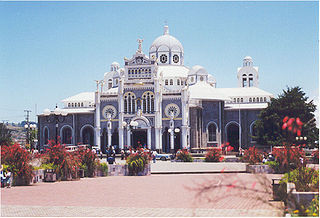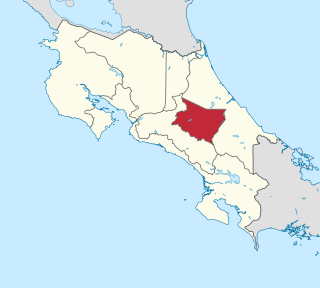
Bristol Zoo was a zoo in the city of Bristol in South West England. The zoo's stated mission was to "maintain and defend" biodiversity through breeding endangered species, conserving threatened species and habitats and promoting a wider understanding of the natural world".

Cartago is the head city of Cartago canton of the Cartago Province, and is composed of the Oriental and Occidental districts as stated in the administrative divisions of Costa Rica. It was the capital of Costa Rica from 1574 to 1824.

Cartago, which means Carthage in Spanish, is a province of central Costa Rica. It is one of the smallest provinces, however probably the richest of the Spanish Colonial era sites and traditions.

The wildlife of Costa Rica comprises all naturally occurring animals, fungi and plants that reside in this Central American country. Costa Rica supports an enormous variety of wildlife, due in large part to its geographic position between North and South America, its neotropical climate, and its wide variety of habitats. Costa Rica is home to more than 500,000 species, which represent nearly 5% of the species estimated worldwide, making Costa Rica one of the 20 countries with the highest biodiversity in the world. Of these 500,000 species, a little more than 300,000 are insects.
The Fort Worth Zoo is a zoo in Fort Worth, Texas, United States, and is home to 7,000 native and exotic animals. It has been named as a top zoo in the nation by Family Life magazine, the Los Angeles Times and USA Today, as well as one of the top zoos in the South by Southern Living Reader's Choice Awards.

The Pacuare River, or the Río Pacuare, in Costa Rica has its source in the Cordillera de Talamanca and flows approximately 108 kilometres (67 mi) to the Caribbean. It is a popular location for white water rafting, whitewater kayaking and riverboarding. The rainforests that surround the river are home to exotic animal species such as jaguars, monkeys, ocelots, and a very large number of birds. It was considered one of the 5 nicest rivers to practice rafting.

Carara National Park is a national park in the Central Pacific Conservation Area located near the Pacific coast of Costa Rica. It was established on 27 April 1978 as a biological reserve, but its growing popularity after 1990 forced the government to upgrade its category to national park in November 1998.

The National Zoo is a Malaysian zoo located on 110 acres (45 ha) of land in Ulu Klang, Gombak District, Selangor, Malaysia. It was officially opened on November 14, 1963, by the country's first prime minister, Tunku Abdul Rahman. The zoo is managed by a non-governmental organization known as the Malaysian Zoological Society and is home to 5,137 animals of 476 different species. It received MS ISO 9001:2008 certification in July 2007 and is a member of the South East Asian Zoos Association (SEAZA). The president and chairman of the zoo is Y. Bhg. Dato' Ismail Hutson.
Turrialba is a canton in the Cartago province of Costa Rica. The head city is in Turrialba district.
Clodomiro Picado Twight, also known as "Clorito Picado", was a Costa Rican scientist who was internationally recognized for his pioneering research on snake venom and the development of various antivenins. His work on molds was a precursor to the formal discovery of penicillin and resulted in compounds which he used to treat patients at least one year before the re-discovery of penicillin by Alexander Fleming. He wrote over 115 works, mainly books and monographs.
The Jaguar Rescue Center is an animal rescue center located near Puerto Viejo de Talamanca in the Limón Province of Costa Rica. The center is dedicated to the rehabilitation of mistreated, injured, orphaned, and/or confiscated animals. Once the animals are fully rehabilitated, they are reintroduced into their natural habitats in protected areas within Costa Rica, usually after a period in La Ceiba primary forest. Visitors are permitted in the center during certain times each day. The center was founded by the Italian biologist Sandro Alviani and his wife Encar García, a Catalan biologist, who runs it with help of volunteers from all around the world and hosts numerous mammals, birds, reptiles, and amphibians. The center also houses a large serpentarium of venomous and nonvenomous snakes native to Costa Rica.

Pejibaye is a district of the Jiménez canton, in the Cartago province of Costa Rica.
Turrialba is a district of the Turrialba canton, in the Cartago province of Costa Rica.

Rescate Wildlife Rescue Center, formerly Rescate Animal Zoo Ave, is an urban park of approximately 14 hectares, located in La Garita, in the canton of Alajuela, Costa Rica. It has an average altitude of 814 meters and is bounded to the north by the bed of the river Rio Poas. The site includes the largest collection of bird species in Latin America.

Serpentario de Monteverde is an urban park of approximately 14 hectares, located in southern Monteverde, in the Puntarenas Province, Costa Rica. It has an average altitude of 1327 meters and is contiguous to the Monteverde Orchid Garden to the north and the Butterfly Garden to the south. The site includes reptiles, poison arrow frogs and over 20 species of snakes. Most species in the serpentarium can be found wild in the surrounding forests.

The Instituto Clodomiro Picado is a research center in Vázquez de Coronado, San José Province, Costa Rica. Established in 1970, the institute is a research unit of the Universidad de Costa Rica, responsible for the production of snake antiophidic serums and scientific research on serpents and their venoms, as well as educational and extension programs in rural areas and hospitals. It received its name in honor of Costa Rican scientist Clodomiro Picado Twight.
La Marina Wildlife Rescue Center, or La Marina Zoo is an animal rescue centre located 8.5 km northeast of Ciudad Quesada, between Palmera and Aguas Zarcas, in the Alajuela Province of Costa Rica. The centre is dedicated to the rehabilitation of mistreated, injured, orphaned, and/or confiscated animals. Once the animals are fully rehabilitated, they are reintroduced into their natural habitats in protected areas within Costa Rica, primarily in the Parque Nacional Juan Castro Blanco to the south of the centre.

The Monteverde Theme Park, previously known as Frog Pond Ranarium, located in Santa Elena, north of Monteverde, Puntarenas Province, Costa Rica, is a frog pond turned animal theme park that houses a butterfly farm with approximately 30 live butterfly species and other insects and over 25 species of frogs and other amphibians from around the country in a climate controlled habitat.

Bothriechis nubestris, the Talamancan palm-pitviper, is a species of pit viper native to cloud forests and montane rainforests in Costa Rica, specifically San José, Cartago and Limón. The snake was mistaken for Bothriechis nigroviridis.
The architecture of Costa Rica includes remains from the pre-Columbian Era, all the way to modern buildings that form part of the nation's contemporary infrastructure. The nation encompasses an array of historical buildings from both the pre-colonial era and post-colonial era, such as Guayabo and the Basilica of Our Lady of the Angels. The contemporary architectural scene in Costa Rica has also captured global attention, exemplified by structures such as Casa Flotanta. Architecture in Costa Rica is reflective of the nation's environmental conservation policies. This is reflected in the distinctive and extensive presence of canopy bridges throughout the nation, constructed in the aim of preventing rainforest destruction.














